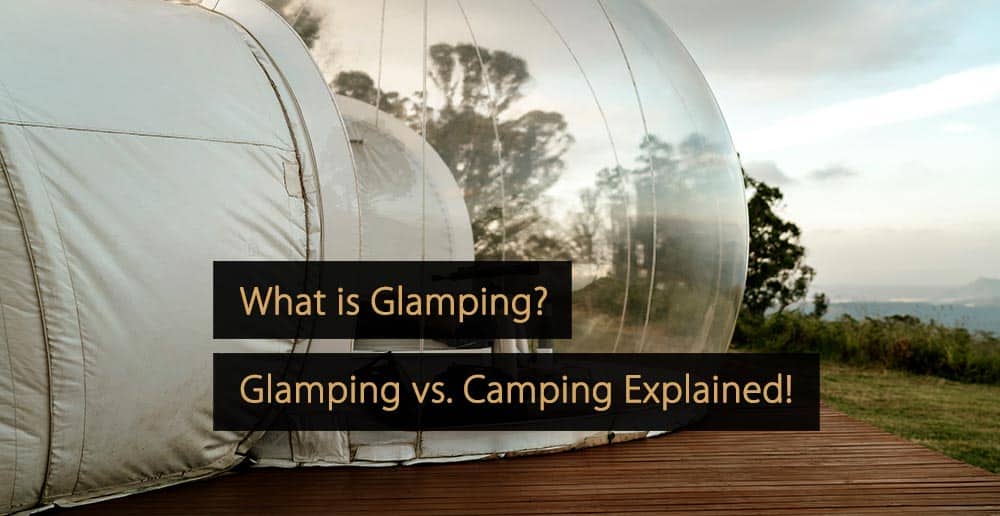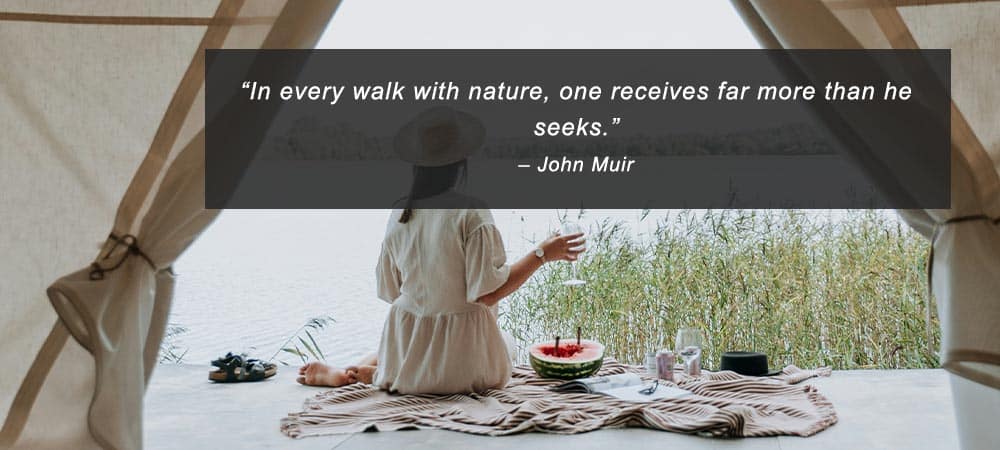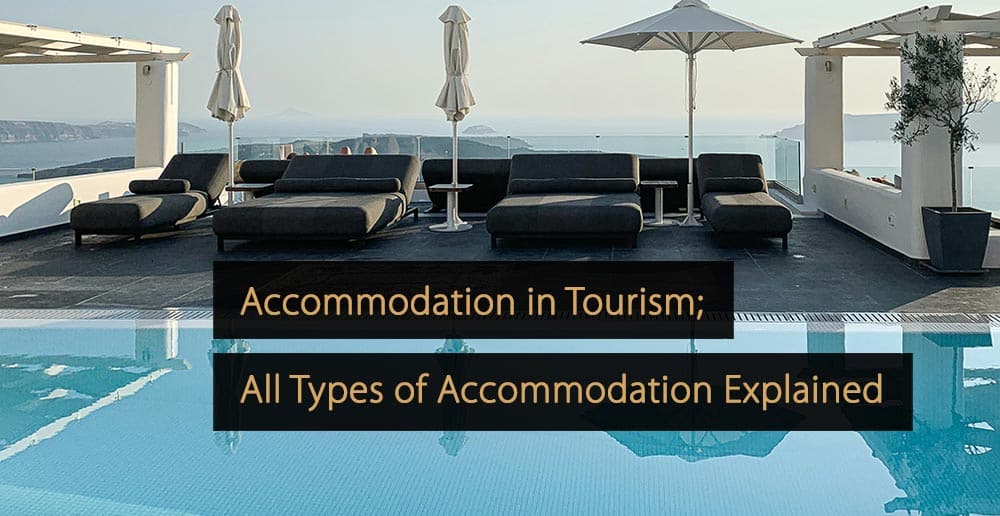The popularity of glamping has grown rapidly in recent years, but what is glamping, and how does it resemble (and differ) from conventional camping? Essentially, it is a more glamorous or luxurious form of the same activity.
Glamping has become an important part of the travel industry, catering for people who want outdoor experiences, but with some extra conveniences. This may include kitchen and bathroom facilities, mattresses and electricity.
In this article, you will find answers to key questions like what is glamping, how does it differ from camping and what do travelers who opt for a glamping trip still need to bring with them?
Table of Contents:
- What is Glamping?
- What is Camping?
- The Advantages and Disadvantages of Glamping
- Glamping vs. Camping: Exploring the Key Differences
- What is the Difference Between Camping Tents and Glamping Tents?
- What Should You Bring With You for Glamping?
- Exploring the Concept of Sustainable Tourism
- Understanding the Importance of Slow Tourism
What is Glamping?
Glamping is a form of camping that provides campers with added luxury elements during their stay. The word ‘glamping’ itself is made up of a combination of the words ‘glamorous’ and ‘camping’.
So what is glamping in practice? It involves staying in a tent, much like conventional camping, but this tent will usually be equipped with comfortable mattresses, while campers will have access to facilities and services that are more commonly associated with hotels and resorts. Examples include electricity and Wi-Fi access.
What can glamping offer travel and tourism customers? Think of the kind of outdoor experiences and sense of adventure that camping offers, but with less of the sacrifices in terms of amenities and services. You will still have a tent and a campsite, but you will benefit from modern comforts and technology as well.
Video: What is Glamping?
What is Camping?
Camping is an outdoor recreational activity, relying on the use of basic shelter like a tent or a camper van for overnight stays. It often takes place in the wilderness, such as in national parks or similar areas of natural beauty.
When camping, people typically bring sleeping bags, a first aid kit, a lantern or another light source, and folding chairs. It is common to start a campfire, which can be used to keep warm and even prepare food. Many people combine camping with other activities, like hiking, or use it as a form of ecotourism.
When exploring the question ‘what is glamping?‘ it is essential to reference camping, as the two activities have so much in common. However, while glamping is one of the fastest-rising travel marketing trends, camping is a firmly established activity, with an enduring appeal due to its associations with outdoor adventure.
The Advantages and Disadvantages of Glamping
Glamping has both advantages and disadvantages, depending on what a person is looking to get out of the experience. So what are the pros and cons of glamping, and what is glamping able to offer that simple camping will not?
In terms of advantages, glamping provides a greater degree of comfort and convenience, making it more appealing to people whose rougher side may put off. You can expect a more comfortable place to sleep and some travel technology, such as internet access, heating and/or entertainment options.
The disadvantages of glamping are broadly the same as the advantages of camping. Many people feel that you cannot truly experience nature and the outdoors without sacrificing modern conveniences. It is also fair to say glamping will be a more expensive way of experiencing the outdoors than traditional camping with simple equipment.
Glamping vs. Camping: Exploring the Key Differences
What is glamping able to offer over camping in terms of features and experiences? In the following sections, you can find out more about the differences between these two activities.
Video: GLAMPING vs CAMPING: 7 Things You Should Know
1. Shelter Quality
The overall quality of the shelter provided by camping and glamping is one of the major areas of difference. With glamping, you can expect a great tent made from quality materials, with modern hotel-like features.
This distinction is important because it explains why glamping appeals to some people who would not be interested in traditional camping. There is far less of a sense of “roughing it” than with camping.
However, some people find the “rougher” nature of camping, away from modern conveniences, to be quite appealing too. When exploring the question of ‘what is glamping?‘ these differences are critical to think through.
2. Equipment and Skills
Another major difference between glamping and camping relates to the equipment and skills required. Out of the two, glamping is much more accessible and far fewer specific skills are needed.
This is an important consideration because not everybody has the skills required to pitch a tent or make a campfire and keep it lit. Some glamping options may provide alternative heating and food preparation options.
So what is glamping going to require in terms of skills and gear? Very little, in truth. Depending on the facilities, you may still need some basic camping skills, but most things will have a convenient solution provided.
3. Amenities
Amenities are the additional conveniences or services that can enhance a travel experience. With wild camping, you will get very little in terms of amenities, although if you go to a campsite, you may get basics, like running water.
The amenities provided can be important in deciding whether someone opts to go camping or glamping. Glamping facilities often offer amenities that you might expect to find within the hotel industry.
What is glamping going to offer the average person in terms of amenities? Think in terms of outdoor seating, toiletries, free Wi-Fi, charging stations, free on-site parking, a fire pit, and kitchen facilities.
4. Comfort Differences
There is a vast comfort level difference between glamping and camping, especially with beds. Glamping sites will usually provide comfortable mattresses and sometimes even full beds, whereas camping usually relies on sleeping bags.
Comfort is an important factor to think about, because the lack of comfort with camping – such as relying on basic shelter and very few on-site facilities – can be off-putting for some people.
Travelers or adventurers who are weighing things up and asking ‘what is glamping?‘ should think carefully about the level of comfort they are anticipating. If you are expecting lots of home comforts, glamping is the right option. If you are actively seeking to get away from comfortable living and experience the true outdoors, camping is better.
5. Cost and Locations
Camping is far more affordable than glamping, requiring only a tent, a few basic items, and a sensible place to stay. By contrast, glamping is more expensive and is much more limited in terms of where it can be done.
This is one of the most important differences to understand, because glamping has to be done in an area that provides the right facilities and amenities. Traditional camping, on the other hand, can be done almost anywhere.
With camping, you do need to understand local laws. However, your camping options may include national parks or other natural locations. With glamping, you usually go to an appropriate glamping site and pay money to stay there.
6. The Overall Experience
Finally, the overall experience is vastly different between camping and glamping. Camping focuses on tackling the outdoors with minimal equipment, whereas glamping is about enjoying the outdoors in a controlled environment.
It is important to understand that, despite some obvious similarities, camping and glamping offer unique experiences. While both involve using shelter in the outdoors, only camping truly engages with nature.
The experience you are looking for will ultimately determine which is the right option. Do you want to know what it is like to live in the wilderness, or do you want to enjoy a comfortable experience with friends or family? Do you want to be self-sufficient in a minimalist tent, or do you want to pay a business in the travel industry?
What is the Difference Between Camping Tents and Glamping Tents?
To adequately answer ‘what is glamping?‘ it is important to consider the fundamental differences between a camping tent and a tent you might utilize for the purpose of glamping.
Camping Tent
A conventional camping tent will be lightweight, mildly durable, and able to withstand rain. It will provide enough space to sit in and sleep, but is unlikely to be big enough to stand up in.
The primary value of a camping tent is that it is a safe place to sleep while outdoors. You will normally have to pitch your own tent in a location of your choice, and you will not have to book through a travel agent or travel management company.
Common materials for camping tents are lightweight nylon and polyester.
Glamping Tent
So what is a glamping tent? While the same basic design principles apply, it will be much larger, made from high-quality materials and usually set up in advance. It will also be more robust and may be semi-permanent.
The differences can be so significant that a glamping tent may more closely resemble a cabin. You will typically have plenty of space to stand up, move around, and fit comfortable beds in the tent.
Common materials for glamping tents include canvas and polycotton, which combine polyester and cotton.
What Should You Bring With You for Glamping?
Although glamping requires less equipment and fewer personal items than camping, you should still make sure you bring the basics. It is important to check what is going to be provided by the glamping location, too:
- Glamping Tent: You will need to find a suitable glamping tent or yurt and the appropriate location. This will usually require a booking, but you may be able to purchase your own glamping tent, too.
- Appropriate Clothing: Make sure you bring clothing that is appropriate for the activities you intend to do. It is also worth bringing some pajamas or warm clothes for nighttime.
- Food and Drinks: Take food, including snacks and meals you can prepare on-site, as well as any drinks you want to consume. You should also bring some basic cutlery and cooking utensils.
- Hygiene Items: Soap, a toothbrush, toothpaste and shampoo are all essential. You should also bring toilet paper unless you are absolutely sure your glamping site is going to provide it for you.
- Bed-Related Items: Depending on the glamping site you are going to, you may need to bring a duvet, pillows and bed sheets, or you may need to bring a sleeping bag. Some glamping sites will provide bedding, however.
- First Aid Equipment: Pack a first aid kit and make sure you know how to use all of the items in it. Basic first aid equipment is a vital item to pack, even if you hope to never need to use it.
You should also ask yourself: what is your glamping site going to provide? Some will provide lighting, chairs, and similar items, but others may not, so consider bringing a lamp and folding chairs if this is the case. You may also want to bring entertainment with you, like books, board games, or a portable games console.
Exploring the Concept of Sustainable Tourism
When examining the ‘what is glamping?‘ question, one thing that needs to be understood is it can be a more sustainable form of travel, often with a rural focus, while placing less demand on resources than hotels typically do. With that being said, the concept of sustainable tourism also includes ideas like soft tourism and community tourism.
In the “Sustainable Tourism Guide: What is, Why Important, Examples and More…” article, you can find out much more about how sustainable tourism is defined, why it matters and what the main examples are.
Understanding the Importance of Slow Tourism
Now you have a clear understanding of what glamping is, it is worth considering a potentially related concept called slow tourism. This is one of the major emerging travel trends and can be summarized as a movement away from mass tourism, towards forms of travel that emphasize meaningful engagement with the local area.
In the “Slow Tourism: What It Is, Its Importance, and Examples” article, you can learn all about slow tourism, what it means, and why it is valuable. You can also access examples of slow tourism in action.
Did You Like This Article About Glamping?
You might also be interested in the following articles:
- Hotel Energy Solution: Save Money and The Planet
- Benefits of Sustainable Tourism Development
- Tourism Meaning: Learn About the Definition of the Tourism Industry
- Tourism Trends: The Latest Opportunities for The Tourism Industry
- Tourism Startups Focus on Innovation and Sustainability
What is glamping and why does it matter? It is essentially a more luxurious form of camping, which is able to appeal to people who want to experience the outdoors while also benefiting from modern conveniences and hotel-like amenities. This makes it a substantially different concept from traditional camping.
More Tips to Grow Your Business
Revfine.com is the leading knowledge platform for the hospitality and travel industry. Professionals use our insights, strategies, and actionable tips to get inspired, optimize revenue, innovate processes, and improve customer experience.Explore expert advice on management, marketing, revenue management, operations, software, and technology in our dedicated Hotel, Hospitality, and Travel & Tourism categories.
This article is written by:
Hi, I am Martijn Barten, founder of Revfine.com. With 20 years of experience in the hospitality industry, I specialize in optimizing revenue by combining revenue management with marketing strategies. I have successfully developed, implemented, and managed revenue management and marketing strategies for individual properties and multi-property portfolios.










Leave A Comment